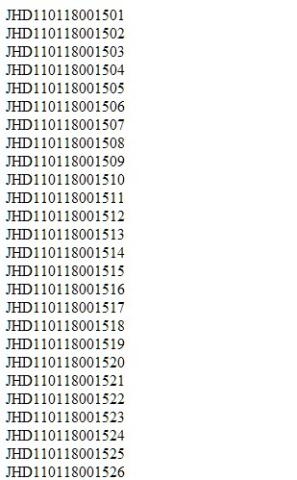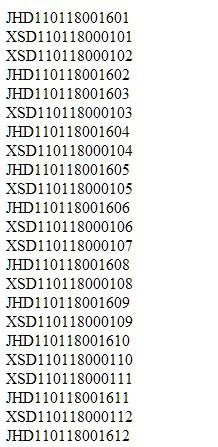关于生成并发唯一性流水号的解决方案
看了文章《弃用数据库自增ID,曝光一下我自己用到的解决方法 》,居然还显示到首页上去。我却觉得如果新手不辨真假,盲目顺从,那么会造成误人子弟的事实。
首先从作者的写这篇文章的目的上讲他想实现的无非是下面
目的:
1、不用自增长ID,因为自增长移植的时候不方便。
2、这个存储过程可以很高效的产生唯一性的自增长ID
从我小虎的认知上来回答:
1、对于作者的第一点,完全可以用Guid来替代自增长,或者在移植的时候,可以先去掉自增长的属性。有的人说Guid性能比不上自增长ID,这里我们先不讨论这一点,个
人认为效率问题主要体现在索引技巧上。
2、关键是作者的第二点,完全是不正确的,也是我写这篇文章的首要目的。因为这个存储过程根本就没有实现在多并发(多用户)的情况下能真正产生唯一性的主键ID。
我们看原作者的代码:
 create procedure [dbo].[up_get_table_key]
create procedure [dbo].[up_get_table_key] 2
 (
( 3
 @table_name varchar(50),
@table_name varchar(50), 4
 @key_value int output
@key_value int output 5
 )
) 6
 as
as 7
 begin
begin 8
 begin tran
begin tran 9
 declare @key int
declare @key int 10

11
 --initialize the key with 1
--initialize the key with 1 12
 set @key=1
set @key=1 13
 --whether the specified table is exist
--whether the specified table is exist 14
 if not exists(select table_name from table_key where table_name=@table_name)
if not exists(select table_name from table_key where table_name=@table_name) 15
 begin
begin 16
 insert into table_key values(@table_name,@key) --default key vlaue:1
insert into table_key values(@table_name,@key) --default key vlaue:1 17
 end
end 18
 -- step increase
-- step increase 19
 else
else 20
 begin
begin 21
 select @key=key_value from table_key with (nolock) where table_name=@table_name
select @key=key_value from table_key with (nolock) where table_name=@table_name 22
 set @key=@key+1
set @key=@key+1 23
 --update the key value by table name
--update the key value by table name 24
 update table_key set key_value=@key where table_name=@table_name
update table_key set key_value=@key where table_name=@table_name 25
 end
end 26
 --set ouput value
--set ouput value 27
 set @key_value=@key
set @key_value=@key 28

29
 --commit tran
--commit tran 30
 commit tran
commit tran 31
 if @@error>0
if @@error>0 32
 rollback tran
rollback tran 33
 end
end请看我的测试代码以及并发结果图

 protected void Page_Load(object sender, EventArgs e)
protected void Page_Load(object sender, EventArgs e)  {
{  if (!IsPostBack)
if (!IsPostBack)  {
{  for (int i = 0; i < 100; i++)
for (int i = 0; i < 100; i++)  {
{  System.Threading.Thread temp3 = new System.Threading.Thread(new System.Threading.ThreadStart(Run3));
System.Threading.Thread temp3 = new System.Threading.Thread(new System.Threading.ThreadStart(Run3));  temp3.Start();
temp3.Start();  }
}  }
}  }
}  private void Run3()
private void Run3()  {
{  System.Data.SqlClient.SqlParameter[] p = {
System.Data.SqlClient.SqlParameter[] p = {  new System.Data.SqlClient.SqlParameter("@table_name", "test"),
new System.Data.SqlClient.SqlParameter("@table_name", "test"),  new System.Data.SqlClient.SqlParameter("@key_value",System.Data.SqlDbType.Int) };
new System.Data.SqlClient.SqlParameter("@key_value",System.Data.SqlDbType.Int) };  p[1].Direction = System.Data.ParameterDirection.Output;
p[1].Direction = System.Data.ParameterDirection.Output;  SqlHelper.ExecuteStoredProcedure("up_get_table_key", p);
SqlHelper.ExecuteStoredProcedure("up_get_table_key", p);  Response.Write(p[1].Value.ToString() + "<br/>");
Response.Write(p[1].Value.ToString() + "<br/>");  }
} 结果图1

从上面多线程的测试效果上来说,绝对不要去按照原
作者的方法去做。
不厚道,说我只说不做,所以,我打算就再写一个切实可行的例子,供大家参考,仅仅作为抛砖引玉。
但是本人是经过多线程测试的,至少在我测试情况下
不会出现并发出差错的情况。
1、表结构和效果图,这个表是用来存储基础因子的,需要的可以拓展字段,比
如,升序,降序,起始序号等。
 CREATE TABLE [dbo].[SerialNo](
CREATE TABLE [dbo].[SerialNo](  [sCode] [varchar](50) NOT NULL,--主键也是多个流水号的类别区分
[sCode] [varchar](50) NOT NULL,--主键也是多个流水号的类别区分  [sName] [varchar](100) NULL,--名称,备注形式
[sName] [varchar](100) NULL,--名称,备注形式  [sQZ] [varchar](50) NULL,--前缀
[sQZ] [varchar](50) NULL,--前缀  [sValue] [varchar](80) NULL,--因子字段
[sValue] [varchar](80) NULL,--因子字段  CONSTRAINT [PK_SerialNo] PRIMARY KEY CLUSTERED
CONSTRAINT [PK_SerialNo] PRIMARY KEY CLUSTERED  (
(  [sCode] ASC
[sCode] ASC  )WITH
)WITH (PAD_INDEX = OFF,
STATISTICS_NORECOMPUTE = OFF, IGNORE_DUP_KEY = OFF, ALLOW_ROW_LOCKS = ON,
 ALLOW_PAGE_LOCKS = ON) ON [PRIMARY]
ALLOW_PAGE_LOCKS = ON) ON [PRIMARY]  ) ON [PRIMARY]
) ON [PRIMARY] 

 Create procedure [dbo].[GetSerialNo]
Create procedure [dbo].[GetSerialNo] 2
 (
( 3
 @sCode varchar(50)
@sCode varchar(50) 4
 )
) 5

6
 as
as 7

8
 --exec
--exec GetSerialNo
9

10
 begin
begin 11

12
 Declare @sValue varchar(16),
Declare @sValue varchar(16), 13

14
 @dToday datetime,
@dToday datetime, 15

16
 @sQZ varchar(50) --这个代表前缀
@sQZ varchar(50) --这个代表前缀 17

18
 Begin Tran
Begin Tran 19

20
 Begin Try
Begin Try 21

22
 --
-- 锁定该条记录,好多人用lock去锁,起始这里只要执行一句update就可以了
23
 --在同一个事物中,执行了update语句之后就会启动锁
--在同一个事物中,执行了update语句之后就会启动锁 24
 Update SerialNo set sValue=sValue where sCode=@sCode
Update SerialNo set sValue=sValue where sCode=@sCode 25

26
 Select @sValue = sValue From SerialNo where sCode=@sCode
Select @sValue = sValue From SerialNo where sCode=@sCode 27

28
 Select @sQZ = sQZ From SerialNo where sCode=@sCode
Select @sQZ = sQZ From SerialNo where sCode=@sCode 29

30
 -- 因子表中没有记录,插入初始值
-- 因子表中没有记录,插入初始值 31

32
 If @sValue is null
If @sValue is null 33

34
 Begin
Begin 35

36
 Select @sValue = convert(bigint, convert(varchar(6), getdate(), 12) + '000001')
Select @sValue = convert(bigint, convert(varchar(6), getdate(), 12) + '000001') 37

38
 Update SerialNo set sValue=@sValue where sCode=@sCode
Update SerialNo set sValue=@sValue where sCode=@sCode 39

40
 end else
end else 41

42
 Begin --因子表中没 有记录
Begin --因子表中没 有记录 43

44
 Select @dToday = substring(@sValue,1,6)
Select @dToday = substring(@sValue,1,6) 45

46
 --如果日期相等,则加1
--如果日期相等,则加1 47

48
 If @dToday = convert(varchar(6), getdate(), 12)
If @dToday = convert(varchar(6), getdate(), 12) 49

50
 Select @sValue = convert(varchar(16), (convert(bigint, @sValue) + 1))
Select @sValue = convert(varchar(16), (convert(bigint, @sValue) + 1)) 51

52
 else --如果日期不 相等,则先赋值日期,流水号从1开始
else --如果日期不 相等,则先赋值日期,流水号从1开始 53

54
 Select @sValue = convert(bigint, convert(varchar(6), getdate(), 12) +'000001')
Select @sValue = convert(bigint, convert(varchar(6), getdate(), 12) +'000001') 55

56

57

58
 Update SerialNo set sValue =@sValue where sCode=@sCode
Update SerialNo set sValue =@sValue where sCode=@sCode 59

60
 End
End 61

62
 Select result = @sQZ+@sValue
Select result = @sQZ+@sValue 63

64
 Commit Tran
Commit Tran 65

66
 End Try
End Try 67

68
 Begin Catch
Begin Catch 69

70
 Rollback Tran
Rollback Tran 71

72
 Select result = 'Error'
Select result = 'Error' 73

74
 End Catch
End Catch 75

76
 end
end 77

78

 |
 |
 |
第一张图(左)是单独对进货单执行循环多进程
第二张图(中)是单独对发货单执行循环多进程
第三张图(右)是对进货单发货单同时执行循环多进程
也就是上面三个Thread,自己注释测试就可以了。
测试并发代码
1 protected void Page_Load(object sender, EventArgs e)
protected void Page_Load(object sender, EventArgs e)
2 {
{
3 if (!IsPostBack)
if (!IsPostBack)
4 {
{
5 for (int i = 0; i < 100; i++)
for (int i = 0; i < 100; i++)
6 {
{
7 System.Threading.Thread temp = new System.Threading.Thread(new System.Threading.ThreadStart(Run));
System.Threading.Thread temp = new System.Threading.Thread(new System.Threading.ThreadStart(Run));
8 System.Threading.Thread temp2 = new System.Threading.Thread(new System.Threading.ThreadStart(Run2));
System.Threading.Thread temp2 = new System.Threading.Thread(new System.Threading.ThreadStart(Run2));
9 System.Threading.Thread temp3 = new System.Threading.Thread(new System.Threading.ThreadStart(Run3));
System.Threading.Thread temp3 = new System.Threading.Thread(new System.Threading.ThreadStart(Run3));
10 temp.Start();
temp.Start();
11 temp2.Start();
temp2.Start();
12 temp3.Start();
temp3.Start();
13 }
}
14 }
}
15 }
}
16
17 private void Run()
private void Run()
18 {
{
19 System.Data.SqlClient.SqlParameter[] p = {
System.Data.SqlClient.SqlParameter[] p = {
20 new System.Data.SqlClient.SqlParameter("@sCode", "JHD") };
new System.Data.SqlClient.SqlParameter("@sCode", "JHD") };
21 Response.Write(SqlHelper.ExecuteStoredProcedure("GetSerialNo", p).Rows[0][0].ToString() + "<br/>");
Response.Write(SqlHelper.ExecuteStoredProcedure("GetSerialNo", p).Rows[0][0].ToString() + "<br/>");
22 }
}
23 private void Run2()
private void Run2()
24 {
{
25 System.Data.SqlClient.SqlParameter[] p = {
System.Data.SqlClient.SqlParameter[] p = {
26 new System.Data.SqlClient.SqlParameter("@sCode", "XSD") };
new System.Data.SqlClient.SqlParameter("@sCode", "XSD") };
27 Response.Write(SqlHelper.ExecuteStoredProcedure("GetSerialNo", p).Rows[0][0].ToString() + "<br/>");
Response.Write(SqlHelper.ExecuteStoredProcedure("GetSerialNo", p).Rows[0][0].ToString() + "<br/>");
28 }
}
29 private void Run3()
private void Run3()
30 {
{
31 System.Data.SqlClient.SqlParameter[] p = {
System.Data.SqlClient.SqlParameter[] p = {
32 new System.Data.SqlClient.SqlParameter("@table_name", "test"),
new System.Data.SqlClient.SqlParameter("@table_name", "test"),
33 new System.Data.SqlClient.SqlParameter("@key_value",System.Data.SqlDbType.Int) };
new System.Data.SqlClient.SqlParameter("@key_value",System.Data.SqlDbType.Int) };
34 p[1].Direction = System.Data.ParameterDirection.Output;
p[1].Direction = System.Data.ParameterDirection.Output;
35 SqlHelper.ExecuteStoredProcedure("up_get_table_key", p);
SqlHelper.ExecuteStoredProcedure("up_get_table_key", p);
36 Response.Write(p[1].Value.ToString() + "<br/>");
Response.Write(p[1].Value.ToString() + "<br/>");
37 }
}
38
总结:我写的整个方法和存储
过程如果要实现流水号的话,还是相当可以的。在当前测试过程中是可以避免并发而导致数据的同步性出错的情况。

